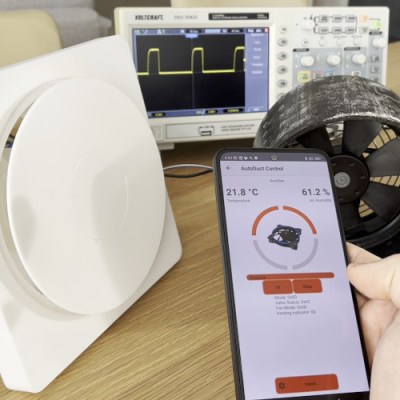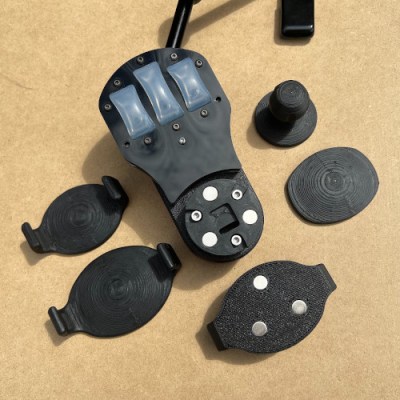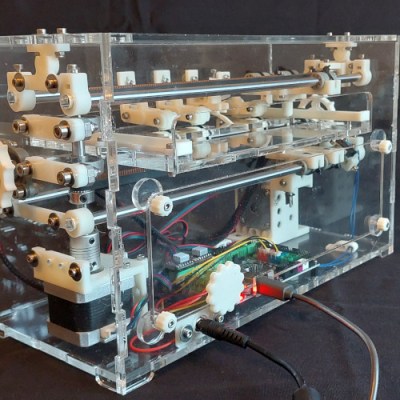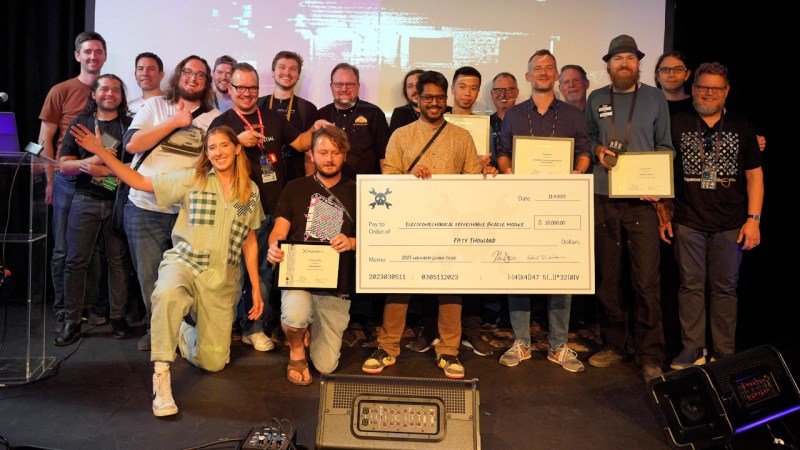It’s a fact of life — all good things must eventually come to an end. The trick is not to focus so much on the chapter that’s closing, but look ahead to what comes next. This is precisely how the Hackaday Prize ended its incredible ten-year run on Saturday during Supercon.
This final year of the competition saw some of the most impressive entries we’ve ever had, leaving us with five exceptionally promising winners. These projects exemplify the qualities that the Hackaday Prize was designed to seek out and amplify and make a perfect capstone for this grand experiment in philanthropic hacking.
Grand Prize: Refreshable Braille Module
 In the 1992 film Sneakers, a blind computer expert named [Whistler] uses a Braille terminal while cracking into several high-profile online services in a scene with about as much technical accuracy as you’d expect for a Hollywood depiction of hacking in the early ’90s. But they did get at least one thing right: computer-connected Braille “displays” have existed for decades.
In the 1992 film Sneakers, a blind computer expert named [Whistler] uses a Braille terminal while cracking into several high-profile online services in a scene with about as much technical accuracy as you’d expect for a Hollywood depiction of hacking in the early ’90s. But they did get at least one thing right: computer-connected Braille “displays” have existed for decades.
Unfortunately, they remain monstrously expensive in the 21st century, to the point of being completely inaccessible for many. On the second-hand market, even outdated models can still command four-figure prices. To try and make this technology more accessible, Vijay spent years working on his Electromechanical Refreshable Braille Module. It leverages both off-the-shelf components and high-resolution 3D printing to provide six individually controlled pins that poke into the user’s fingers. Unlike commercial units, which use expensive piezo-electric actuated pins, his design utilizes an array of tiny electromagnets to rotate even tinier cams. Build up an array of 40 or even 80 of these modules, and you’ll be hacking along with [Whistler] in no time.

-
Second Place: Jumperless
Jumperless by Kevin Santo Cappuccio is very much like your standard breadboard. But where it differs is that with this board, you don’t even need wires. Just plug in your components use the computer to make your connections virtually, and the array of crosspoint switches on the Jumperless will do the work for you.
- The addition of RGB LEDs is a masterstroke, as it not only allows you to visualize the “wires” connecting each component but can communicate all sorts of information about the circuit’s performance.

-
Third Place: AutoDuct
Daniel Porzig’s AutoDuct is designed to improve the efficiency of decentralized HVAC systems, specifically in apartments. Each unit has a humidity and temperature sensor, which allows the vent’s PIC32 microcontroller to increase or decrease airflow as necessary automatically.
- This can put less burden on the building’s existing HVAC system with a relatively small investment. As an added bonus, the vent’s shutters can also help block unwanted noise from outside.

-
Fourth Place: OHMni-Stick
The OHMni-stick is an open-source assistive technology device designed to help those with limited motor ability. It uses a low-torque joystick and pneumatic pressure-sensitive buttons.
- By lowering both the force and range of movement necessary to operate the device, the OHMni-stick is easier to actuate than more traditional input devices, especially for users with minimal strength and mobility. Customizable grips can make operating the device more comfortable, and its open-source nature makes it more accessible to a larger range of users.

-
Fifth Place: BrailleRAP
The BrailleRAP project seeks to provide a way to make printing Braille documents cheaper and more accessible. Using parts commonly found in desktop 3D printers, the open-source machine can emboss Braille into paper and even thin sheets of plastic and metal.
- Inspired by the RepRap project, which helped drive down the cost of DIY 3D printers, an individual can assemble their own BrailleRAP for as little as $250 USD — compared to commercial offerings, which can easily cost ten times as much.

-
Protolabs Grant: AI Recycle Bin
Looking to increase the amount of household refuse that gets recycled, Samuel Alexander designed this bin, which can automatically sort materials based on the sound they make when they’re tossed inside. After the sound has been classified by the bin’s machine learning algorithm, the segmented drum in the bottom of the unit rotates so the object falls into the appropriate compartment.
- While such an elaborate device might not end up in everyone’s home, it offers value as an educational tool in public spaces.
Looking to the Future
The Hackaday Prize has had a phenomenal ten-year run, and while we’re sad that it has to end, we’re incredibly proud that it’s ending on such a high note. Providing seed money to get a project like the Electromechanical Braille Display off the ground is an honor, and looking back over the years, the Prize has done that repeatedly. We believe the Hackaday Prize has made a difference, and the last decade’s entrants are a testament to what small groups of determined hackers can get done.
In place of the Prize, we’ll be running more focused contests with the same goals of improving the world through our collective efforts. We’re still working out the details, but we’d like to continue to be able to encourage progress in the open-source hardware and software where it most matters. While this is the end of the Hackaday Prize as a giant monolith, our commitment to helping you to help us all isn’t going to change.


















I’m sad to see the Hackaday Prize sunset… will you continue to have Supercon?
Absolutely!
RIP Hackaday prize 😭😭😭😭😭😭😭
Cool story, bro.
Thanks! :P
I’m confused. Who’s Brian or is it some code word as in ‘The Life of Briam’ and Brian is our Hacker Saviour, ie the new Messiah?
I think it’s wise to end the prize in favor of smaller contests. It was frequently the case where apples and oranges projects were competing against each other and I felt like I often didn’t agree with the winning selection. Bring on small contests!
Yep, I found I often did not agree with the judges, especially when my own projects did not reach the finals.
This, I stopped even entering since there’s no way I can compete with projects supported by teams of engineers with an actual budget that have way more resources.
Suppose you’ve never considered that maybe your ideas just aren’t as good as you think they are?
The top winner is literally a self-taught dude from India, where are these teams of engineers you’re talking about?
And you’ve never even considered that you don’t even know me and have no idea what projects I’ve made? Imagine accusing a stranger of hubris and being high and mighty without any knowledge yourself? What projects have you even made to sit there and judge me?
Seems like you’ve done no research, there are a number of project submissions that are clearly put together by multiple people, some clearly startups (if you’d looked at the submission list for more than a second even you’d spot them, it’s not my job to educate you). But no, it’s far easier to insult a stranger and post a single data point as “proof” that I’m incorrect so you can stoke your ego.
I’ve often pondered why we don’t have fully automated AI trash sorting now, given all the hype around far-out problems like self-driving cars etc. By comparison it feels like it should be super easy for AI to guide a robot to perfectly pick recyclables out of the waste stream with incredible efficiency and yet we still have armies of under-paid humans (sometimes even low-risk prisoners) doing the job by hand.
Maybe something for a future HaD article to dive into?
As an elaboration on your comment, have people logging into a web page to control the robot arms remotely. This way, even high risk prisoners can be used to sort our trash.
Ai could be used to check they’re doing the job properly and if not, a suitable punishment dealt out.
I love that comment because it will lead to a movie about a genious prisoner who uses telehands to construct a robot that then comes aids in him escape from prison.
Congratulations for 10y of success, supporting creativity and innovation! I hope you develop more ways to encourage tech hack! See u soon!
What an impressive finale to the Hackaday Prize! These innovations showcase the spirit of creative problem-solving. Excited to see what the future holds for the next generation of projects and innovators! 👏🚀
The Hackaday prize was a source on inspiration for many years, I always told myself that one day I should enter it. Guess I’m too late now!
Thanks for all the hard work you all have put in for the last decade!